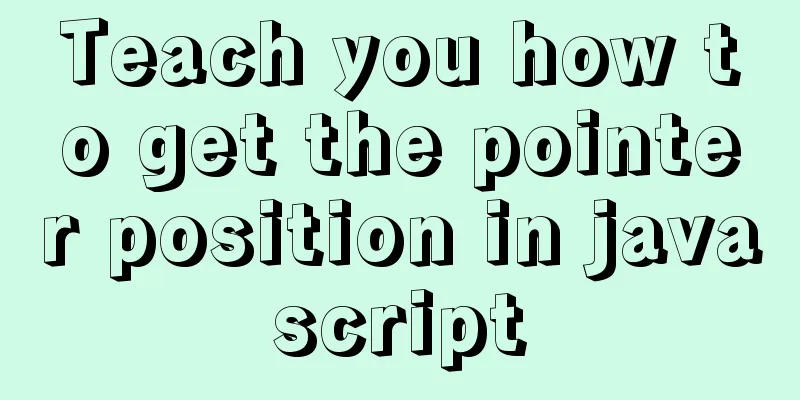Teach you how to get the pointer position in javascript

|
The method of obtaining the position of the pointer in javascript is: using the pageX and pageY, or clientX and clientY properties of the event object, and cooperating with the scrollLeft and scrollTop properties, so that the position of the pointer can be calculated.
The operating environment of this article: Windows 10 system, JavaScript 1.8.5, ThinkPad T480 computer. To get the position of the pointer on the page, you can use the pageX and pageY, or clientX and clientY (IE compatible) properties of the event object, and also need to cooperate with the scrollLeft and scrollTop properties, so that you can calculate the position of the mouse pointer on the page.
//Get the page position of the mouse pointer //Parameter: e represents the current event object //Return value: Returns the coordinates of the mouse relative to the page, object format (x, y)
function getMP(e) {
var e = e || window.event;
return {
x : e.pageX || e.clientX + (document.documentElement.scrollLeft || document.body.scrollLeft),
y : e.pageY || e.clientY + (document.documentElement.scrollTop || document.body.scrollTop)
}
}The pageX and pageY event attributes are not supported by IE browsers, and the clientX and clientY event attributes are not supported by Safari browsers, so you can mix them to be compatible with different browsers. For quirks mode, the body element represents the page area, and the html element is hidden, but in standard mode, the html element represents the page area, and the body element is only an independent page element, so these two parsing methods need to be compatible. The following example demonstrates how to call the above extended function getMP() to capture the current position of the mouse pointer in the document.
<body style="width:2000px;height:2000px;">
<textarea id="t" cols="15" rows="4" style="position:fixed;left:50px;top:50px;"></textarea>
</body>
<script>
var t = document.getElementById("t");
document.onmousemove = function(e){
var m = getMP(e);
t.value = "mouseX = " + mx + "\n" + "mouseY = " + my
}
</script>The demonstration effect is as follows:
Get the relative position of the pointer Use offsetX and offsetY or layerX and layerY to get the offset position of the mouse pointer relative to the containing box. If you use the offsetLeft and offsetTop properties to get the offset coordinates of the element in the positioning containing box, and then use the layerx property value to subtract the offsetLeft property value, and use the layery property value to subtract the offsetTop property value, you can get the position of the mouse pointer inside the element.
//Get the position of the mouse pointer within the element //Parameters: e represents the current event object, o represents the current element //Return value: Returns the relative coordinate object function getME (e, o) {
var e = e || window.event;
return {
x : e.offsetX || (e.layerX - o.offsetLeft),
y : e.offsetY || (e.layerY - o.offsetTop)
}
}In practice, the above function has the following two problems:
Considering the influence of border on mouse position, when the border of an element is very wide, we must consider how to eliminate the influence of border on mouse position. However, due to different border styles, it has a default width of 3 pixels, which brings trouble to obtaining the actual width of the element's border. More conditions need to be set to determine the border width of the current element. Example The improved extended function for getting the position of the mouse pointer within an element is as follows:
//Perfectly obtain the position of the mouse pointer within the element //Parameters: e represents the current event object, o represents the current element //Return value: Returns the coordinate position of the mouse relative to the element, where x represents the x-axis offset distance and y represents the y-axis offset distance function getME(e, o){
var e = e || window.event;
//Get the width of the left border of the element //Call the getStyle() extension function to get the border style value and try to convert it to a numerical value. If the conversion is successful, assign the value.
//Otherwise, determine whether the border style is defined. If the border style is defined and the value is not none, it means that the border width is the default value, which is 3 pixels.
//If no border style is defined and the width value is auto, the border width is 0
var bl = parseInt(getStyle(o, "borderLeftWidth")) || ((o.style.borderLeftStyle && o.style.borderLeftStyle != "none" )? 3 : 0);
//Get the width of the top border of the element. The design idea is the same as that of getting the left border. var bt = parseInt(getStyle(o, "borderTopWidth")) || ((o.style.borderTopStyle && o.style.borderTopStyle !="none" ) ? 3 : 0);
var x = e.offsetX || (e.layerX - o.offsetLeft - bl); // Mouse offset value for general browsers // Compatible with Mozilla browsers, minus border width var y = e.offsetY || (e.layerY - o.offsetTop - bt); // Mouse offset value for general browsers // Compatible with Mozilla browsers, minus border width var u = navigator.userAgent; // Get browser user data if( (u.indexOf("KHTML") > - 1) ||(u.indexOf("Konqueror") > - 1) || (u.indexOf("AppleWebKit") > - 1)
){ // If it is Safari browser, subtract the border effect x -= bl; y -= bt;
} return { // Returns a mouse position object compatible with different browsers, with the upper left corner of the inner wall of the element border as the positioning origin x: x, y: y
}
}The demonstration effect is as follows:
Recommended learning: JavaScript video tutorial This is the end of this article about how to get the pointer position in javascript. For more information about the location of js pointer, please search previous articles on 123WORDPRESS.COM or continue to browse the related articles below. I hope you will support 123WORDPRESS.COM in the future! You may also be interested in:
|
<<: W3C Tutorial (10): W3C XQuery Activities
>>: Ubuntu Server 18.04.5 LTS Server Edition Installation and Configuration Graphic Tutorial
Recommend
JavaScript implements long image scrolling effect
This article shares the specific code of JavaScri...
Examples of using the ES6 spread operator
Table of contents What are spread and rest operat...
Solve the problem of garbled data in MySQL database migration
Under the instructions of my leader, I took over ...
HTML iframe usage summary collection
Detailed Analysis of Iframe Usage <iframe frame...
CSS style to center the HTML tag in the browser
CSS style: Copy code The code is as follows: <s...
Sample code for implementing Alipay sandbox payment with Vue+SpringBoot
First, download a series of things from the Alipa...
Continuous delivery using Jenkins and Docker under Docker
1. What is Continuous Delivery The software produ...
The failure to play flv/MP4 and other video files on the website is related to the MIME type.
When making a website, I found that video files, s...
Detailed explanation of the calculation method of flex-grow and flex-shrink in flex layout
Flex(彈性布局) in CSS can flexibly control the layout...
Detailed explanation of JavaScript's built-in Date object
Table of contents Date Object Creating a Date Obj...
Enter the style file for the automatic search suggestion function: suggestion.css
Copy code The code is as follows: .sugLayerDiv{ p...
Ubuntu 18.04 MySQL 8.0 installation and configuration method graphic tutorial
This article shares the installation and configur...
A brief analysis of the difference between ref and toRef in Vue3
1. ref is copied, the view will be updated If you...
Semantics: Is Html/Xhtml really standards-compliant?
<br />Original text: http://jorux.com/archiv...
JavaScript to implement login slider verification
This article example shares the specific code of ...












